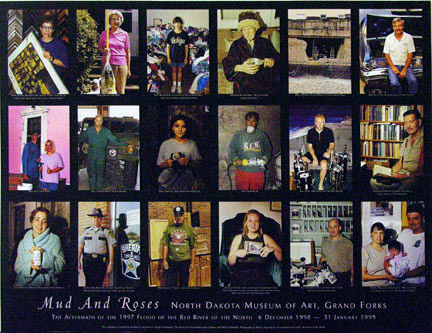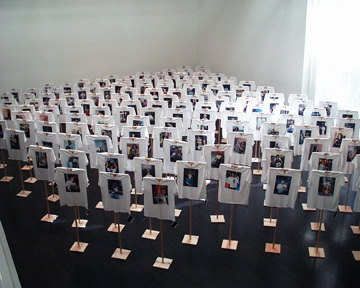timeline
1972The North Dakota Museum of Art (NDMOA) was officially founded by Laurel Reuter as the University Art Galleries located on the top floor of the University of North Dakota (UND) Student Union. At the time Reuter was a graduate student in American literature. | |
1973Reuter appointed herself director—and no one cared. Early exhibitions included “Tulsa” by Larry Clark (1971, when the gallery was just a start-up Student Union operation). Solo shows followed by Fritz Scholder (1974), Ed Ruscha (1975), David Gilhooly (1978), Frank Gohlke (1979—organized by New York’s Museum of Modern Art), Sol LeWitt (1980), N. Scott Momaday (1981—his first museum exhibition), Jaune Quick-to-See Smith (1981—her first museum exhibition), and a two-person exhibition by Elmer Bischoff and David Parks (1986).
| |
1976The institution launched its Mobile Gallery program to tour exhibitions, starting with “Indian Images” [in Contemporary Art]. Jo Keeling cashed in her Museum secretary position for a Class 1 trucker license, hired her brother Mark to join her, and set off in their tractor/trailer gallery to tour all of North Dakota, followed by Iowa, Minnesota, South Dakota, and Wisconsin before ending at the Calgary Stampede in Alberta, Canada.
|  |
1979Eleanor Caponigro began a longtime relationship with the institution as a freelance book and graphic designer, establishing the Museum’s printed aesthetic.
| |
1981The North Dakota State Legislature designated the University Art Galleries as North Dakota's Official Art Gallery, and the name was changed to the North Dakota Museum of Art.
| |
1984The Friends of the North Dakota Museum of Art was established to serve as an advisory and fundraising body to the University owned entity. It was incorporated in 1986. The Board of the Museum’s Friends group functioned as “trustees” until 1996 when the Friends Board officially became the Museum’s Board of Trustees after NDMOA separated from the University. During the early years key leadership was provided by Corinne Alphson, David and Julie Blehm, Virginia Dunnigan, Jean Holland, Bruce Gjovig, Barb Lander, Darrell Larson, Robert Lewis, Ellen McKinnon, Suzanne Ryan, Gerald Skogley, David Hasbargen, Wayne Zimmerman, and Carol and Rex Wiederanders.
| |
1985The Museum organized “Homecomings,” to reintroduce to the Museum’s audience leading American Indian artists from the across the United States.
| 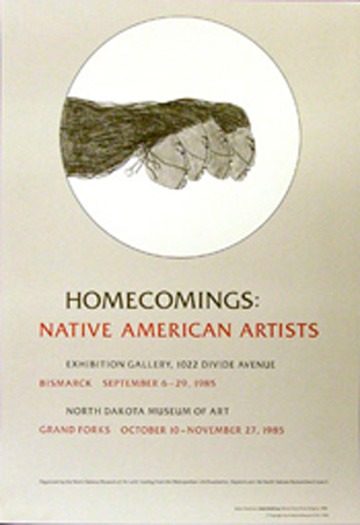 |
1988The Museum organized its first international touring exhibition, Frontiers in Fiber: The Americans. Supported by the United States Information Agency, the show toured to thirteen Pacific Rim countries plus China as one of four official exhibitions. The Museum staff was installing the show in Beijing on June 4, 1989, when the Tiananmen Square protest exploded. The exhibition went into storage in Hong Kong for a year as both Beijing and Hangzhou were canceled. The exhibition introduced the new Contemporary Fiber movement to Asian audiences steeped in the great historical traditions of the East.
| |
1989The Museum opened its permanent home, a 1907 basketball gymnasium located on the campus of UND. The renovation was funded by Laura Christianson who established a Museum building fund in 1968 that ultimately grew to one million dollars. The University agreed to lease the gymnasium to the Museum for $1 if the Friends raised the additional $400,000 needed for the transformation. Modernist architect Harvey Hoshour of Albuquerque designed the renovation; Grand Forks architect Gary Johnson developed the working plans and oversaw construction. Hoshour graduated first in his class at MIT and worked for I. M. Pei and later Mies van der Rohe before establishing his own firm in New Mexico. He died during construction, so artists participated in designing the public restrooms (neon artist Cork Marcheschi), the gift shop and the donor wall (Barton Benes), and the sculpture garden (Richard Nonas). The Museum celebrated the grand opening in 1989 with a grant from the National Endowment for the Arts to begin to purchase work for the permanent collection. The Museum published its first exhibition catalog Peter Dean, a 68-page paperback designed by Eleanor Caponigro with essays by Laurel Reuter and Carter Ratcliff. Many followed, including Georgie Papageorge in 1995, which was written and produced by Laurel Reuter in conjunction with this South African artist’s first museum exhibition. That same year the Museum published Autobiography in conjunction with an exhibition by Canadian artists Stephen Andrews, Kal Asmundson, and Caroline Dukes. By 1995 Reuter was editing and designing almost all of the Museum’s publications.
| 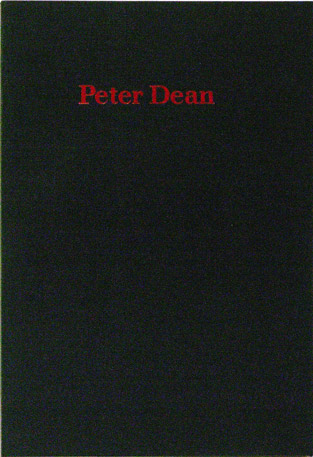 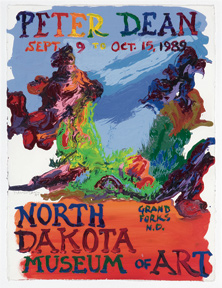 |
1991The Museum Concert Series was founded to bring classical musicians of international stature to perform Sunday afternoons during the winter season. The Series was organized in collaboration with nearby Mayville State University. Madelyn Camrud joined the staff in Audience Development. The exhibition, “Seeing through ‘Paradise’: artists and the Terezín concentration camp,” organized by the Massachusetts College of Art, came to NDMOA after opening in Boston with a stop at New York’s Drawing Center.
| |
1992NDMOA opened the first of two solo exhibitions by Chinese artist Xu Bing. He subsequently made important gifts to the collection. Madelyn Camrud inaugurated the Museum’s first annual Benefit Dinner and Silent Auction, which grew into one of the region’s leading social events while raising money for both the artists and general operating. It established the precedent of not asking artists to donate their work. Instead, once the artists’ minimums were reached, they and the Museum shared the proceeds of the sale.
| |
1996In November, the Museum underwent further institutional change when UND turned over management of the Museum to an independent Board of Trustees as a 501(c)(3), a private nonprofit cultural institution. The University gave the Museum a one-time monetary donation of $92,198 to assist with general operating expenses; after that, the Museum was financially on its own. The annual Elaine McKenzie Memorial Lecture was established. She and Marilyn Fundingsland were key staff during the transition of NDMOA from a University gallery.
| |
1997In April, a critical event in the Museum's history occurred which tested all physical, psychological, and spiritual resources. The Red River overflowed in North Dakota, Minnesota, and Manitoba, devastating the entire region but especially Grand Forks and East Grand Forks. On an immediate basis, the Museum proved its disaster preparedness; more importantly, in the months after the flood, the Museum transformed itself into a center for community life—becoming a national model for the changing role of museums in society. Only 5% of all buildings in the city were dry. The Museum, among the lucky, became a center of community life. People flocked in for free concerts coupled with community-wide potluck suppers. The burned-out North Dakota Ballet Company held regular practice sessions. Habitat for Humanity took up residence. Special art classes were held for uprooted and displaced young children. The galleries, while continuing to show difficult, contemporary art, became the home of the fundamentalist Bible Baptist Church—three times a week for eighteen months. In addition, NDMOA began projects to move the community forward and to bring artists into the conversation: The Oral History Project was run by staff member Dr. Eliot Glassheim. Three books resulted: Voices from the Flood, which recorded the oral histories of ordinary people. Uncommon Heroes: The City of the Grand Forks Flood Fight written by Dr. Kimberly Porter, a historian of disasters and a specialist in oral history. “Uncommon Heroes” resulted from 800 hours of oral interviews with over 250 citizens, employees, and elected and appointed officials of Greater Grand Forks who engaged in a Herculean effort to save this river community from the forces of nature. And Behind the Scenes: Leadership in a Natural Disaster which recounted the inside story of fighting the flood, as told by federal, state and local officials who were behind the scenes as decisions were being made. Glassheim edited the third book. Flood of Memories, a commissioned play by Frances Ford, was adapted from the Oral History Project. Sculptor Adam Kemp created its monumental set from the refuse of the flood. Children’s Mural Project: When parents came back after the evacuation, they faced enormous financial obstacles and endless work. Businesses were destroyed; homes were either uninhabitable or lost forever. The Museum began a six-week Children’s Mural Project to help youngsters process what had happened to them and to give parents a place to leave the children for a few hours each day. The project was so successful that the Museum staff was requested to hold workshops for elementary teachers who wanted to run their own mural programs once school was back in session in the fall. Under the Whelming Tide was an exhibition curated and organized by Laurel Reuter and Grand Forks Herald news photographers Eric Hylden with assistance from Jackie Lorentz, and Chuck Kimmerle. The exhibition and accompanying book told the story of the flood with photos taken by over fifty North American photographers, including photojournalists such as Mary Ellen Mark, staff newspaper and magazine photographers from across the continent (i.e. National Geographic and Life), plus artists and amateur photographers. Museum Design Forum consisted of a series of nationally respected thinkers in areas of urban design, architecture, and landscape design who conducted seminars with the general public as the city moved forward with rebuilding. Elizabeth Plater-Zyberk, Randall Arendt, William Morrish, and Michael Mercil were among those who came to Grand Forks to speak and have breakfast with public officials and local planners. Mud and Roses — The Aftermath of the 1997 Flood: The North Dakota Museum of Art commissioned the following artists to create works based on the flood. The goal was to take the experience of the local people and transform it through art into a universal experience.
Recognition for the Museum’s flood work included:
Since this “watershed" event, which literally has marked the Museum's history into antediluvian and postdiluvian periods, the Museum has strengthened itself regionally and nationally while forming deep bonds within its own community. Just prior to the flood, the Museum was finalizing plans to launch both an endowment and the annual membership drive. Consequently, neither occurred. Following national news of the flood, however, the Henry Luce Foundation gave the Museum an unsolicited grant of $150,000 over two years. Also, the Saint Paul, Minnesota Bush Foundation invited the Museum into its Regional Arts Development Program which resulted in sixteen years of general operating support at $100,000 annually.
|
|
1998The North Dakota Museum of Art Foundation was established as a separate 501(c)(3) and charged with raising and managing Museum major gifts and endowments. Gerald Skogley became the Founding Chairman. Sanny Ryan, a member of the new foundation, invested one-million dollars in an annuity with the guarantee to pay out $60,000 annually for staff salaries. Summer Arts Day Camp for children began with six full-week sessions led by Education Director Morgan Owens. In 2001-02 Sue Fink assumed responsibility for the popular camps, all taught by working artists. She continues as the Museum’s Director of Education. The annual Autumn Art Auction was inaugurated by Madelyn Camrud. A live auction, the event supported the Museum’s goal to build a buying audience for artists so they might afford to stay in the region. “William Kentridge: Weighing . . . and Wanting” opened in October. The exhibition included the animation Weighing...and Wanting and the accompanying drawings by this important contemporary South African artist.
| |
1999Two years after the flood, agriculture went into a major slump, which impacted the regional economy, including the Museum. Trustee Jean Holland made a significant financial gift to see the Museum through the post-flood, agricultural turndown years.
| |
2000Museum staff began the research and development for several exhibitions around contemporary political life and human rights issues.
| |
2002“Re-Imagining New York,” an exhibition of nine landscape painters who lost their studios on the 91st floor of the World Trade Center, opened in August. Nancy Friese, an artist with deep ties to North Dakota, was one of the nine. Soon after 9/11, Friese wrote, I feel so numb, having worked so hard . . . over twenty paintings completed. It is more than a disaster; it is unfathomable. And I feel so small, mourning my paintings, missing my brushes when others lost everything. Struck by the universality of disaster, Reuter was reminded of the flood that devastated her own community in 1997. She had seen the same guilt felt by those who didn’t lose everything. She also remembered that those who continued working moved through the experience with greater peace, albeit accompanied by similar loss and exhaustion. Her friend needed to go back to painting. Thus the idea of the exhibition was born, an exhibition as much about survival, and memory and loss, as about painting. Friese agreed to curate the show.
| 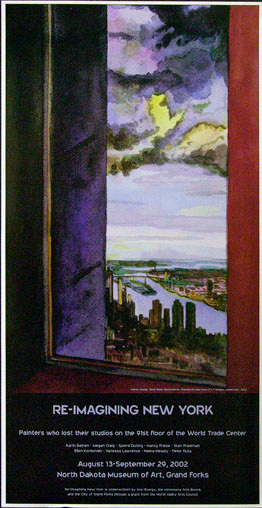 |
2004Following the downing of the World Trade Center towers, or 9/11, the Museum organized and curated “Snow Country Prison: Interned in North Dakota.” It opened and toured within North Dakota through 2008. The exhibition grew out of the observation that just as anyone who looked Japanese or was Japanese-American during World War II was deemed an enemy, anyone who appeared to be of Middle Eastern decent became suspect after 9/11. The Museum launched the Rural Arts Initiative, an educational outreach program to encourage and empower rural school children and their teachers to actively participate in learning through museum exhibitions. Funded by the State of North Dakota, Museum staff takes exhibitions to rural communities as far as 400 miles away. NDMOA embarked upon a large commissioning project, “The Emptying Out of the Plains,” which resulted in books and films, including the video installation The Plains of Sweet Regret by Mary Lucier, photographic commissions by Jim Dow (with book Marking the Land: Jim Dow in North Dakota), Jon Solinger, and Robert Polidori, and mixed-media installations by Aganetha and Richard Dyck. Funding began to come in from national foundations for exhibitions and commissioning projects. They included the Nathan Cummings Foundation, the Andy Warhol Foundation, the Archer Daniels Midland Foundation, the Lannan Foundation, and the Annenberg Foundation.
| |
2005NDMOA opened “The Disappeared” exhibition that brought together the work of thirteen Latin American artists—both famous and unknown—making art in response to the twentieth-century military dictatorship and civil wars that rocked their countries and “disappeared” thousands of people. “The Disappeared” traveled to five Latin American cities and six cities in the United States. The catalog published by Charta International of Milan. Other Museum exhibitions began tours after opening in North Dakota. These included “Mouths of Ash,” a solo exhibition by Colombian Juan Manuel Echavarría, which toured nationally through 2007 and was included in Houston’s FotoFest, followed by the Weatherspoon Museum of Art in North Carolina (catalog). Mary Lucier’s Plains of Sweet Regret was seen at the University of Michigan Museum of Art, the Amon Carter Museum in Fort Worth, the Birmingham Museum of Art, and multiple sites in North and South Dakota, Wyoming, and Colorado (catalog).
| 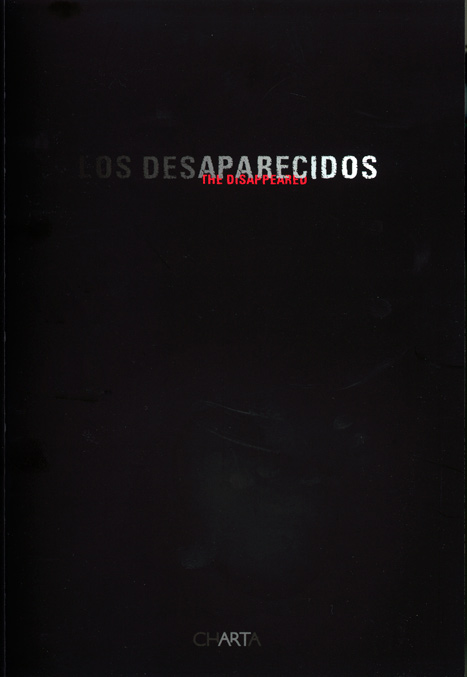  |
2006Critic Holland Cotter reviewed “The Disappeared” in The New York Times writing, It is scheduled to travel through South America for three years, and has a bilingual catalog that is a work of art in itself. From Ms. Reuter’s stunning essay to the supplementary material, it is a total-immersion experience. And why is it that an on-the-road exhibition from a small museum in the Midwest is the most potent show of contemporary art, political or otherwise, in town? All I can say is that curators in our local museums should pay a visit, and ask themselves that question. (June 6, 2007). The show went on to win many prizes and recognitions including being named one of NewsDay’s top ten art events in 2007 in New York City.
| |
2007Marking the Land: Jim Dow in North Dakota was chosen by American Photo magazine as one of the top ten photography books in 2007. Laurel Reuter won the Apple Valley [California] Foundation’s 2007 $10,000 Curatorial Excellence Award in recognition of her exemplary curatorial work on “The Disappeared,” and the University of North Dakota bestowed upon her an Honorary Doctorate of Letters. The New York Times announced Barton Lidice Benes’ gift to NDMOA of the contents of his New York City, Westbeth apartment. Upon his death it is slated to become the Museum’s first period room, a Twenty-first Century Artist’s Studio stuffed with collections of African, Egyptian, Amazonian, and contemporary art. The Museum inaugurated Concerts in the Garden, a casual summer series spotlighting musicians of various persuasions including fusion, blues, jazz, and rock. A neighborly event, people of all ages bring lawn chairs, eat burgers, watch children dance, and listen to musicians from across the United States. Staff member Matt Wallace founded and directs the program.
| 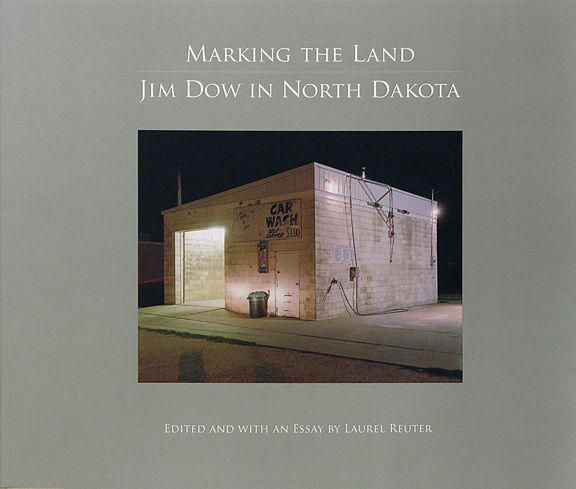 |
2009Wayne Zimmerman took over as President of the Board of Trustees following in the footsteps of David Hasbargen, John Foster, Ann Brown, Bruce Gjovig, Gerald Skogley, Barbara Lander, Suzanne Ryan, Virginia Dunnigan, and Robert Lewis.
| |
2010McCanna House was established upon the death of Margery McCanna Jennison as the site of the Museum’s artist-in-residence program. A long-time supporter of the Museum, she left her ancestral home, ten acres, and $100,000 in seed money for an endowment. It is located thirty miles west of Grand Forks in the village of McCanna, North Dakota. Oakland artist John Rogers, who grew up in Grand Forks, is heading up the program.
| 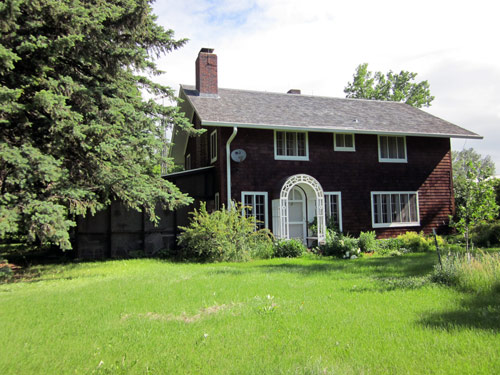 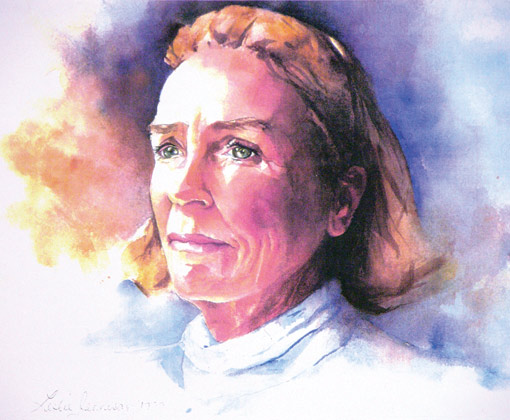 |
2011The Museum mounted the first of two major exhibitions to spotlight the growing permanent collection. “Language: Concrete and Abstract” explored three broad categories of communication: 1) The written language of prose and poetry that is transformed or embedded into a work of art, 2) The combination of spoken and visual language that bombards contemporary people especially by television and film as found in Iranian Shaoja Azari’s Coffee House Painting, and, 3) Art that is abstracted from reality or that, although abstract, might suggest recognizable imagery, however subtle or vague.
| |
2012“People’s Gold” followed. Western North Dakota has Black Gold in the form of coal and oil. Eastern North Dakota has People’s Gold in the form of arts and culture. “People’s Gold” included work by fifty-two artists in the Museum’s collection. All but five were living artists who come from across the United States and Canada, Japan, Argentina, Colombia, Bangladesh, Ethiopia, South America, France, Mexico, and Wales. In 2012, the Museum accepted over $390,000 in art by thirty-nine living artists into the collection—a large figure for a small museum on the Northern Plains. The Rauschenberg Foundation announced that NDMOA was one of nine recipients of the inaugural round of grant making under their Artistic Innovation and Collaboration Grant Program. The Museum was slated to receive $150,000 over three years to support the commissioning of artists Rena Effendi, Bill Harbort, John Hitchcock, Terry Jelsing, Mary Lucier, and Tim Schouten to create work exploring contemporary life on North Dakota’s mixed race, multi-cultural Spirit Lake Nation of the Dakota (Sioux) people.
| 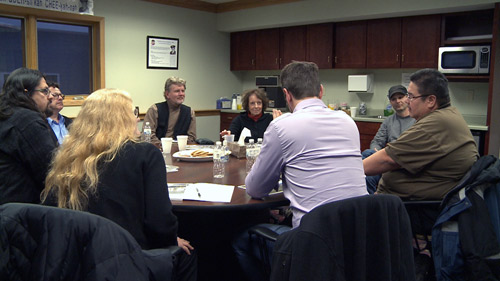 |

